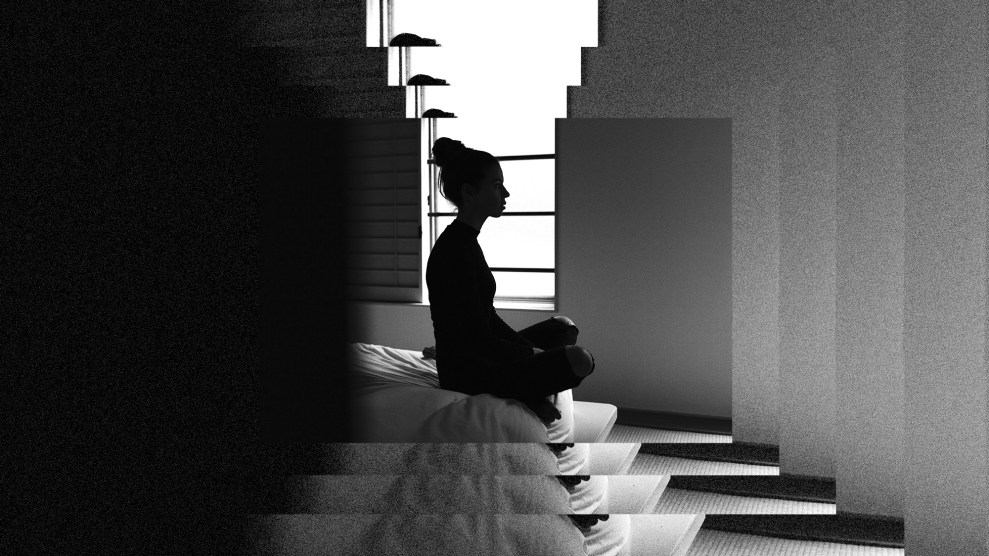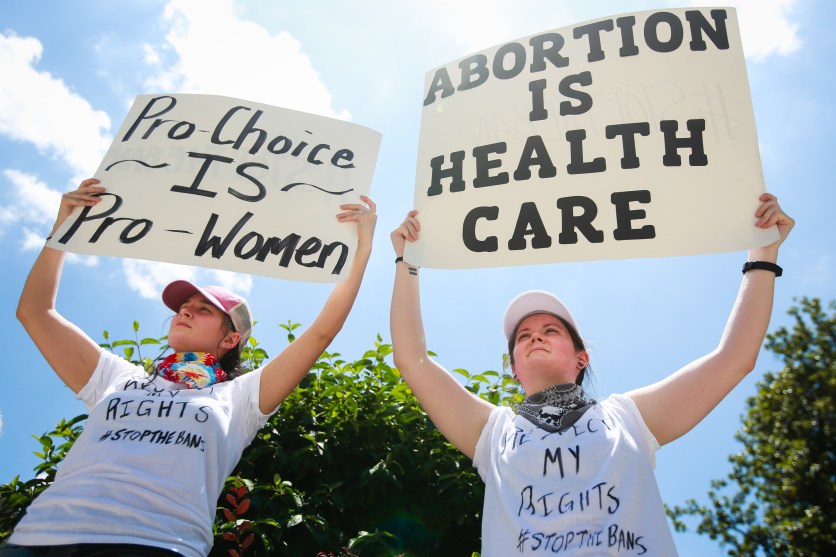
Mother Jones illustration; Ben Blennerhassett/Unsplash
When the Supreme Court decided recently to consider Mississippi’s 15-week abortion ban, Marjorie Dannenfelser from Susan B. Anthony List said: “This is a landmark opportunity for the Supreme Court to recognize the right of states to protect unborn children from the horrors of painful late-term abortions.”
Dannenfelser’s choice to invoke “late-term abortions” was pointed. Typically, the phrase refers to abortions performed after 21 weeks, but I’ve seen anti-abortion advocates in particular use “late term” in reference to abortions anywhere after 15 weeks. Crucially, there is no real definition or medical designation for what constitutes a late-term abortion, so it’s used somewhat haphazardly. Medical experts also criticize the term for implying that abortions are taking place after a pregnancy reaches “term” at 37 weeks—which does not happen—or a point in pregnancy referred to by obstetricians as “late term,” up to 41 weeks—which also does not happen.
But the squishiness of the term means it has become an effective weapon, easily evoking an ill-defined evil as it leaks into broader vernacular. And as a result, even erstwhile abortion rights supporters often show an urge to explain “late-term” abortions as needing justification. You’re familiar with the milieu, which goes something like this: Abortions after 15 weeks are rare, and these are heartbreaking cases where the pregnancy was wanted and something went horribly wrong.
But the reality is, these are simply medical procedures given to those who need them. As Laurie Bertram Roberts, who runs the Mississippi Reproductive Freedom Fund, puts it, the seemingly arbitrary 15-week mark “was right there where people start getting a little bit like, ‘Well, why would someone need an abortion that late?'”
The reasons why people get them are often not all that different from “early-term” ones; in fact, many patients want to get their abortions earlier—but stigma, paired with the ever-growing net of restrictions pushed by lawmakers who claim to want to “protect women,” creates barriers that push people further into pregnancy before they can get care. Jessy Rosales knows from experience.
When she was 20 years old, she needed an abortion. At the time, she was a student at UC Riverside, where she led a campus reproductive justice advocacy group—she was quite aware of what was happening to her body and familiar with what needed to be done. What she didn’t anticipate was all the barriers she herself would face, all the stumbling blocks that sprang up between her and the care she desperately required, even in a state that’s considered to be a bastion for abortion access. It was the fall of 2016 when she started to feel sick; she went to the student health center, which confirmed she was pregnant, but because it did not have an ultrasound machine, she could not know how far along she was in the pregnancy. The health center referred her to a family planning clinic where they said she could arrange abortion care, but when she called them, they told her they don’t offer those services. In fact, the voice on the other end of the line said, she was not the first to call asking for an abortion, and though the clinic had told the student health center that abortion services weren’t available, students were continuing to be referred there anyhow.
“It absolutely blew my mind,” she remembers. “What the fuck is this about? I’m going to get this thing out of me; time’s a-tickin’ and things are growing.”
Determined as she was, the logistics kept ensnaring her. Another referral to yet another clinic, where she waited weeks for a November appointment, before being told her insurance wasn’t accepted there. Back to the student health center, where there was more bureaucracy and red tape. It was difficult to navigate; the daughter of undocumented immigrants, Rosales grew up thinking of the health care system as a threat, a way to potentially be uprooted and tossed back across the border like unwanted weeds. Her family had only sought medical care when absolutely necessary, and consequently Rosales didn’t have much experience with the mountains of paperwork and insurance minutiae that can baffle even the savviest person. It also didn’t help that everyone she spoke to during this process seemed reluctant to say the word “abortion”; it gave her the feeling that she was doing something inherently evil.
And on top of all that, finals were fast approaching.
“I didn’t know what I was doing, but I knew that I wanted an abortion,” she tells me. “It wasn’t even that I wanted to have a later abortion, it was the fact that everything was just in my way, everything that I could possibly think of—from having a support system to finding a place that would actually do this for me, to having the money, to having the transportation. I didn’t have a car at the time. I was just dealing with all of this alone, and I felt like such a fraud, because on Wednesdays at 5, 6 p.m. I was talking about the importance of advocating for reproductive justice, and I couldn’t even achieve that for myself.”
The waiting was the worst part. Rosales says being stuck in the knowledge that she was pregnant and did not want to be, and there was very little she could do about it, was agonizing. “It felt so painful to have a body that wasn’t my own,” she says. Finally, she was able to get an appointment at a Planned Parenthood, where they told her she conceived sometime in late August; she was at least 16 weeks along, possibly 18. She had her abortion, but it was much later than she wanted it, through no fault of her own.
Now, the futures of people like Rosales are in the hands of the Supreme Court. The case, Dobbs v. Jackson Women’s Health Organization, reviews Mississippi’s 15-week ban on abortion, which is currently not in effect, as a federal judge ruled it unconstitutional in 2018. So while abortion, at least for now, remains legal in Mississippi, and the United States writ large, the court’s move has made abortion protections increasingly vulnerable. Abortion rights advocates are alarmed, as they cannot see a scenario in which a ruling does not affect the precedent set in Roe v. Wade that made abortion care a constitutional right; anti-abortion advocates are thrilled for all the same reasons.
The discourse throughout oral arguments later this year, and leading up to the ruling that will likely come in spring 2022, will inevitably include, as Dannenfelser previewed, this idea of “late-term” abortion and, more subtly, what makes it morally acceptable. It will be hard to avoid even among well-meaning feminists who are arguing against gestational bans; they too can fall into the trap of pointing out how rare and heartbreaking these cases are. I have even been guilty of it in my own reporting. But it’s necessary to have a conversation about the ways this framing generates stigma for those who don’t fit neatly into that narrative.
Advocates like Renee Bracey Sherman, founder and executive director of We Testify, an abortion storytelling nonprofit, have seen the damage wrought by these kinds of remarks firsthand. This language, she tells me, means “erasing all of the people who have later abortions for different reasons.” She says, “You’re making it sound as if they have done something wrong and that their need for an abortion is not justified, and you’re then saying that the only abortions—when it comes to later abortions—that should be defensible are the ones in which people have to experience some sort of violence or harm to their body, and not that you just deserve access because you are a human being inside of the United States who is deserving of abortion access.”
This rings true for Rosales, and also for Jenn Chalifoux, who discovered she was pregnant while receiving treatment for an eating disorder in 2010. She wasn’t getting her period because she was malnourished and her weight fluctuated as she went through treatment and recovery. At first, she remembers, “I was surrounded by doctors, none of whom thought I could be pregnant. I was on birth control. I’d been on birth control for a couple years.” By the time she and her doctors realized she was pregnant, she was into her second trimester. “I was definitely mentally ill at that point and was having a hard time taking care of myself. And so I was like, OK, I know I want an abortion,” Chalifoux says. “But finding out that I was so late changed a lot about how I was able to get one, and so that was hard, too, because I felt like I had been cheated.”
Data from the Guttmacher Institute, a think tank that researches reproductive health care, confirms that pregnant people who get abortion care past the first trimester are often doing so because there were barriers that took time to overcome. A 2004 survey showed that 58 percent of abortion patients would have preferred to get care earlier in pregnancy. A 2014 analysis showed that “women with less education, black women and women who had experienced multiple disruptive life events (such as unemployment or separation from a partner) in the past year were more likely than others to have had an abortion at or beyond 13 weeks’ gestation,” and that distance from abortion providers—which are increasingly far for more and more people—as well as waiting periods, another growing phenomenon, are also significant factors that delay care. The authors of the Turnaway Study, a 10-year study which was published by the University of California, San Francisco, and examines the lasting effects on people who are turned away from abortion care, estimate that more than 4,000 women are denied abortion care annually due to gestational limits, and thousands more will be affected as these laws continue to proliferate in state legislatures.
“[Anti-abortion state lawmakers] continue to have these earlier and earlier gestational bans that they’re pushing on the far end, and then on the other end, they make it harder and harder to get an abortion—you have to have a waiting period, you have to raise money, you have to find a clinic that will take you, you have to get your insurance to cover all that stuff, which is something that pushes people later and later on the other end,” Bracey Sherman explains. “Basically, people who have abortions are being squeezed on either end, and all the while, the anti-abortion movement is saying, ‘This is a really big decision, you should take your time to think about it,’ while then criminalizing you for taking the time to think about it.”
Roberts, who is also the executive director for Alabama’s Yellowhammer Fund, is intimately familiar with what it takes to get abortion care for those who need it. “My normal person is really someone who’s low income, who got pushed back due to money,” she says. “So maybe at 11 weeks, they knew they wanted to have their procedure, but they didn’t have the money. So then that meant their price went up. At 12 weeks, they now needed $700. And then they couldn’t get the $700 together, and now they need $800. You see where this is going.”
When it comes to creating abortion laws that seek to challenge Roe’s precedent, as the Mississippi ban does, the stigma is the point. Roberts adds that it’s easy to judge others when there is a lack of understanding about barriers to abortion in this country. “I think it’s important to make sure you’re telling stories beyond people who were going through the loss of a wanted pregnancy,” she tells me. “Yes, fetal anomaly is very real, and it happens, but it’s also just normal folks who end up getting pushed back and pushed back and pushed back.”
The problem “isn’t abortion,” Rosales says. “The problem is people’s rhetoric around abortion.”














